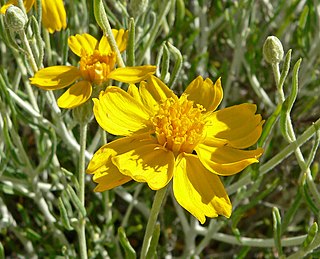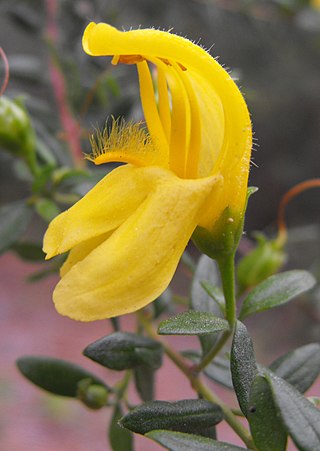
Chaparral is a shrubland plant community found primarily in California, in southern Oregon and in the northern portion of the Baja California Peninsula in Mexico. It is shaped by a Mediterranean climate and infrequent, high-intensity crown fires.

Larrea tridentata, called creosote bush and greasewood as a plant, chaparral as a medicinal herb, and gobernadora in Mexico, due to its ability to secure more water by inhibiting the growth of nearby plants. In Sonora, it is more commonly called hediondilla; Spanish hediondo = "smelly".

The Sonoran Desert is a hot desert in North America and ecoregion that covers the northwestern Mexican states of Sonora, Baja California, and Baja California Sur, as well as part of the southwestern United States. It is the hottest desert in both Mexico and the United States. It has an area of 260,000 square kilometers (100,000 sq mi).

Salvia funerea, is a species of semi-deciduous perennial shrub with the common names Death Valley sage, woolly sage, and funeral sage, is an intricately branched shrub associated with limestone soils in the Mojave Desert in California and Nevada. It is characterized by an overall white appearance due to wooly hairs that cover the stems and leaves.

Parkinsonia florida, the blue palo verde, is a species of palo verde native to the Sonoran Deserts in the Southwestern United States and Northwestern Mexico. Its name means "green pole or stick" in Spanish, referring to the green trunk and branches, that perform photosynthesis.

Eriogonum fasciculatum is a species of wild buckwheat known by the common names California buckwheat and flat-topped buckwheat. Characterized by small, white and pink flower clusters that give off a cottony effect, this species grows variably from a patchy mat to a wide shrub, with the flowers turning a rusty color after blooming. This plant is of great benefit across its various habitats, providing an important food resource for a diversity of insect and mammal species. It also provides numerous ecosystem services for humans, including erosion control, post-fire mitigation, increases in crop yields when planted in hedgerows, and high habitat restoration value.

Calliandra eriophylla, commonly known as fairy duster, is a low spreading shrub which is native to deserts and arid grasslands in California, Arizona, New Mexico, Texas, and Mexico.

Psilostrophe cooperi is a flowering plant in the daisy family known by the common names Cooper's paper daisy and whitestem paperflower. It is native to the Mojave and Sonoran Deserts of California, the Southwestern United States, and northwestern Mexico.

Atriplex hymenelytra, the desert holly, is silvery-whitish-gray shrub in the family Amaranthaceae, native to deserts of the southwestern United States. It is the most drought tolerant saltbush in North America. It can tolerate the hottest and driest sites in Death Valley, and remains active most of the year.

Coleogyne ramosissima or blackbrush, is a low lying, dark grayish-green, aromatic, spiny, perennial, soft wooded shrub, native to the deserts of the southwestern United States. It is called blackbrush because the gray branches darken when wet by rains. It is in the rose family (Rosaceae), and is the only species in the monotypic genus Coleogyne.

Condea emoryi, the desert lavender, is a large, multi-stemmed shrub species of flowering plant in Lamiaceae, the mint family.

Fagonia laevis, the California fagonbush, is a species of plant in the Zygophyllaceae, the caltrop family. It is a perennial subshrub of the southwestern United States and Northwestern Mexico desert regions in California, southern Nevada, Arizona, southwest Utah, Sonora, Baja California and Baja California Sur. It thrives upon hot, dry, slopes and hillsides that also receive seasonal-(winters of the Southwest) or monsoon moisture.

Keckiella antirrhinoides is a species of flowering shrub in the plantain family known by the common names snapdragon penstemon and chaparral beardtongue.

The deserts of California are the distinct deserts that each have unique ecosystems and habitats. The deserts are home to a sociocultural and historical "Old West" collection of legends, districts, and communities, and they also form a popular tourism region of dramatic natural features and recreational development. Part of this region was even proposed to become a new county due to cultural, economic and geographic differences relative to the rest of the more urban region.

Rafinesquia neomexicana is a species of flowering plant in the family Asteraceae. Common names include desert chicory, plumeseed, or New Mexico plumeseed. It has white showy flowers, milky sap, and weak, zigzag stems, that may grow up through other shrubs for support. It is an annual plant found in dry climate areas of the southwestern deserts of the US and northwestern deserts of Mexico.

Tetracoccus hallii is a species of flowering shrub in the family Picrodendraceae, known by the common names Hall's shrubby-spurge and Hall's tetracoccus.

Greasewood is a common name shared by several plants:

Ambrosia salsola, commonly called cheesebush, winged ragweed, burrobush, white burrobrush, and desert pearl, is a species of perennial shrub in the family Asteraceae native to deserts of the southwestern United States and northwestern Mexico.

Cuscuta denticulata, commonly known as desert dodder or small-toothed dodder, is a thin, yellow to orange, parasitic annual vine in the morning glory family (Convulvulaceae), native to the deserts of the south-western United States and northern Mexico.

Ebenopsis confinis is a species of drought deciduous perennial shrubs in the Legume family known commonly as dog poop bush. The English vernacular name is a result of the distinctive woody fruits which resemble dog poop. The plant is referred to locally as palo fierro. In addition to the fruits, this species is characterized by its small, equally-paired pinnate leaves and a condensed capitulum. This species is distributed from southern Baja California to the cape of Baja California Sur, and on the coast of Sonora.




















